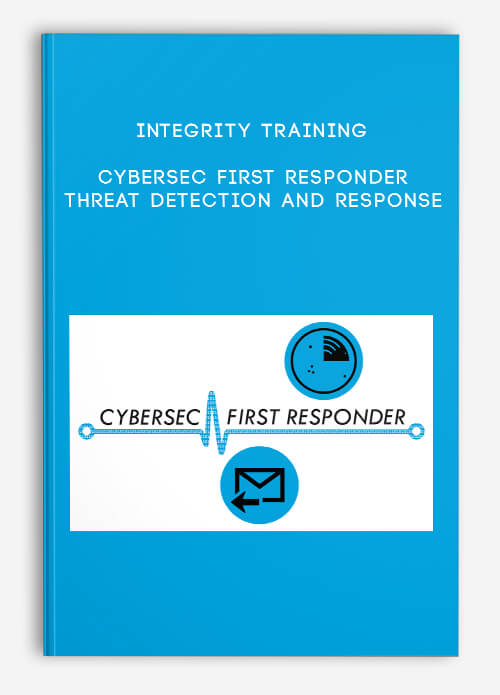Integrity Training – CyberSec First Responder: Threat Detection and Response
$299.00 $72.00
Product Include:
File size:
Integrity Training – CyberSec First Responder: Threat Detection and Response
**More information:
Get Integrity Training – CyberSec First Responder: Threat Detection and Response at Salaedu.com
Description
The CyberSec First Responder: Threat Detection and Response course prepares the candidates to protect the IT infrastructure of their organizations against cyber-attacks. The course also teaches the candidates to execute a properly planned response to such incidents. The tools and techniques taught in this course are independent of the size and scope of the organization as the course is based on the common threats, risks and their mitigation techniques which are applicable universally.
The candidates are advised to have some knowledge of basic networking technologies such as TCP/IP, routing protocols, network security and VPNs. In addition to this, the candidates are also supposed to have at least two years of professional experience in network administration or a similar field.
Prerequisites:
Some knowledge of basic networking technologies such as TCP/IP, routing protocols, network security and VPNs
Student Materials:
Student Workbook
Student Prep Guide
Certification Exams:
CyberSec First Responder: Threat Detection & Response CFR210
Who Should Attend?
- Cybersecurity practitioners
- Information systems security engineers
- Information security officers
- IT administrators
Course Curriculum
Course Introduction
StartIntroduction (0:09)
StartCourse Introduction (1:12)
StartInstructor Introduction (0:22)
Assessing Information Security Risk
StartIntroduction (0:22)
StartTopic A: Identify the Importance of Risk Management (0:28)
StartElements of Cybersecurity (Perimeter Model) (1:26)
StartElements of Cybersecurity (Endpoint Model) (1:38)
StartThe Risk Equation (0:54)
StartRisk Management (0:56)
StartThe Importance of Risk Management (0:43)
StartERM (0:42)
StartReasons to Implement ERM (1:02)
StartRisk Exposure (0:25)
StartRisk Analysis Methods (1:22)
StartRisks Facing an Enterprise (1:10)
StartTopic B: Assess Risk (0:32)
StartESA Frameworks (0:28)
StartESA Framework Assessment Process Part1 (0:43)
StartESA Framework Assessment Process Part2 (0:44)
StartNew and Changing Business Models (0:40)
StartDe-perimeterization (1:41)
StartNew Products and Technologies (1:23)
StartInternal and External Influences (0:55)
StartSystem-Specific Risk Analysis (0:38)
StartRisk Determinations (2:58)
StartDocumentation of Assessment Results (0:36)
StartGuidelines for Assessing Risk (2:01)
StartTopic C: Mitigate Risk (0:51)
StartClasses of Information (1:16)
StartClassification of Information Types into CIA Levels (1:51)
StartSecurity Control Categories (1:15)
StartTechnical Controls (Template) (0:26)
StartTechnical Controls (Example Answer) (0:36)
StartAggregate CIA Score (3:08)
StartCommon Vulnerability Scoring System (1:54)
StartCommon Vulnerabilities and Exposures (0:30)
StartDemo – Common Vulnerability Scoring System (5:41)
StartExtreme Scenario Planning and Worst Case Scenarios (1:12)
StartRisk Response Techniques (1:10)
StartAdditional Risk Management Strategies (1:40)
StartContinuous Monitoring and Improvement (0:27)
StartIT Governance (0:31)
StartGuidelines for Mitigating Risk (1:12)
StartTopic D: Integrate Documentation into Risk Management (0:29)
StartFrom Policy to Procedures (1:17)
StartPolicy Development (0:14)
StartProcess and Procedure Development (0:10)
StartDemo – Finding a Policy Template (5:20)
StartTopics to Include in Security Policies and Procedures (0:36)
StartBest Practices to Incorporate in Security Policies and Procedures Part1 (1:34)
StartBest Practices to Incorporate in Security Policies and Procedures Part2 (0:59)
StartBusiness Documents That Support Security Initiatives (1:50)
StartGuidelines for Integrating Documentation into Risk Management Part1 (1:06)
StartGuidelines for Integrating Documentation into Risk Management Part2 (0:46)
StartSection Review (0:21)
StartReview Questions
Analyzing the Threat Landscape
StartIntroduction (0:14)
StartTopic A: Classify Threats and Threat Profiles (0:30)
StartThreat Actors Part1 (1:12)
StartThreat Actors Part2 (0:44)
StartThreat Motives (0:39)
StartThreat Intentions (0:39)
StartAttack Vectors (0:41)
StartAttack Technique Criteria (1:20)
StartQualitative Threat and Impact Analysis (0:54)
StartGuidelines for Classifying Threats and Threat Profiles (0:39)
StartTopic B: Perform Ongoing Threat Research (0:30)
StartOngoing Research (0:47)
StartSituational Awareness (0:30)
StartCommonly Targeted Assets (1:56)
StartThe Latest Vulnerabilities (1:21)
StartThe Latest Threats and Exploits (1:28)
StartThe Latest Security Technologies (1:07)
StartResources Aiding in Research Part1 (0:52)
StartResources Aiding in Research Part2 (0:21)
StartDemo – Resources that Aid in Research of Threats (3:02)
StartThe Global Cybersecurity Industry and Community (0:43)
StartTrend Data (0:16)
StartTrend Data and Qualifying Threats (1:01)
StartGuidelines for Performing Ongoing Threat Research (1:25)
StartSection Review (0:28)
StartReview Questions
Analyzing Reconnaissance Threats to Computing and Network Environments
StartIntroduction (0:21)
StartTopic A: Implement Threat Modeling (0:25)
StartThe Diverse Nature of Threats (0:36)
StartThe Anatomy of a Cyber Attack (2:13)
StartThreat Modeling (0:37)
StartReasons to Implement Threat Modeling (0:32)
StartThreat Modeling Process (1:15)
StartAttack Tree (1:35)
StartThreat Modeling Tools (0:24)
StartThreat Categories (1:27)
StartTopic B: Assess the Impact of Reconnaissance Incidents (0:37)
StartFootprinting, Scanning, and Enumeration (1:15)
StartFootprinting Methods (1:35)
StartNetwork and System Scanning Methods (0:41)
StartEnumeration Methods (1:05)
StartEvasion Techniques for Reconnaissance (2:06)
StartReconnaissance Tools (2:38)
StartPacket Trace Analysis with Wireshark (0:31)
StartDemo – Performing Reconnaissance on a Network (7:22)
StartDemo – Examining Reconnaissance Incidents (8:10)
StartTopic C: Assess the Impact of Social Engineering (0:25)
StartSocial Engineering (2:09)
StartTypes of Social Engineering Part1 (1:52)
StartTypes of Social Engineering Part2 (1:44)
StartTypes of Social Engineering Part3 (1:09)
StartPhishing and Delivery Media (0:47)
StartPhishing and Common Components (1:14)
StartSocial Engineering for Reconnaissance (0:49)
StartDemo – Assessing the Impact of Social Engineering (7:37)
StartDemo – Assessing the Impact of Phishing (3:23)
StartSection Review (0:26)
StartReview Questions
Analyzing Attacks on Computing and Network Environments
StartIntroduction (0:21)
StartTopic A: Assess the Impact of System Hacking Attacks (0:19)
StartSystem Hacking Part1 (0:29)
StartSystem Hacking Part2 (0:28)
StartSystem Hacking Part3 (0:32)
StartSystem Hacking Part4 (0:29)
StartSystem Hacking Part5 (0:26)
StartSystem Hacking Part6 (0:23)
StartPassword Sniffing (0:57)
StartPassword Cracking (3:58)
StartDemo – Cracking Passwords Using a Password File (8:30)
StartPrivilege Escalation (0:57)
StartSocial Engineering for Systems Hacking (0:25)
StartSystem Hacking Tools and Exploitation Frameworks (1:06)
StartTopic B: Assess the Impact of Web-Based Attacks (0:26)
StartClient-Side vs. Server-Side Attacks (1:09)
StartXSS (0:56)
StartXSRF (0:58)
StartSQL Injection (1:47)
StartDirectory Traversal (1:58)
StartFile Inclusion (1:24)
StartAdditional Web Application Vulnerabilities and Exploits (1:16)
StartWeb Services Exploits (1:09)
StartWeb-Based Attack Tools (0:20)
StartDemo – Assessing the Impact of Web-Based Threats (3:24)
StartTopic C: Assess the Impact of Malware (0:22)
StartMalware Categories (4:55)
StartTrojan Horse (0:46)
StartPolymorphic Virus (0:15)
StartSpyware (1:09)
StartSupply Chain Attack (0:40)
StartMalware Tools (0:16)
StartDemo – Malware Detection and Removal (5:35)
StartTopic D: Assess the Impact of Hijacking and Impersonation Attacks (0:28)
StartSpoofing, Impersonation, and Hijacking (0:42)
StartARP Spoofing (5:12)
StartDNS Poisoning (1:35)
StartICMP Redirect (0:58)
StartDHCP Spoofing (2:32)
StartNBNS Spoofing (1:16)
StartSession Hijacking (0:44)
StartHijacking and Spoofing Tools (0:23)
StartTopic E: Assess the Impact of DoS Incidents (0:23)
StartDoS Attacks (1:58)
StartDoS Attack Techniques (4:37)
StartDDoS (0:53)
StartDoS Evasion Techniques (1:31)
StartDoS Tools (0:27)
StartDemo – Assessing the Impact of DoS Attacks (4:06)
StartTopic F: Assess the Impact of Threats to Mobile Security (0:27)
StartTrends in Mobile Security (2:37)
StartWireless Threats (1:51)
StartBYOD Threats (1:33)
StartMobile Platform Threats (2:11)
StartMobile Infrastructure Hacking Tools (0:17)
StartTopic G: Assess the Impact of Threats to Cloud Security (0:19)
StartCloud Infrastructure Challenges (1:56)
StartThreats to Virtualized Environments (3:37)
StartThreats to Big Data (1:33)
StartExample of a Cloud Infrastructure Attack (1:22)
StartCloud Platform Security (1:09)
StartSection Review (0:21)
StartReview Questions
Analyzing Post -Attack Techniques
StartIntroduction (0:38)
StartTopic A: Assess Command and Control Techniques (0:23)
StartCommand and Control (1:00)
StartIRC (0:33)
StartHTTP/S (0:56)
StartDNS (2:02)
StartICMP (1:48)
StartAdditional Channels (1:31)
StartDemo – Assessing Command and Control Techniques (10:37)
StartTopic B: Assess Persistence Techniques (0:21)
StartAdvanced Persistent Threat (0:52)
StartRootkits (0:50)
StartBackdoors (0:37)
StartLogic Bomb (0:24)
StartDemo – Detecting Rootkits (3:45)
StartRogue Accounts (2:04)
StartTopic C: Assess Lateral Movement and Pivoting Techniques (0:24)
StartLateral Movement (1:41)
StartPass the Hash (1:39)
StartGolden Ticket (2:25)
StartRemote Access Services (0:59)
StartWMIC (1:41)
StartPsExec (1:04)
StartPort Forwarding (1:11)
StartVPN Pivoting (0:57)
StartSSH Pivoting (0:42)
StartRouting Tables and Pivoting (0:26)
StartTopic D: Assess Data Exfiltration Techniques (0:17)
StartData Exfiltration (0:43)
StartCovert Channels (1:34)
StartSteganography (1:03)
StartDemo – Steganography (3:51)
StartFile Sharing Services (0:25)
StartTopic E: Assess Anti -Forensics Techniques (0:37)
StartAnti -Forensics (0:46)
StartGolden Ticket and Anti -Forensics (0:44)
StartDemo – Assessing Anti -Forensics (3:44)
StartBuffer Overflows (0:42)
StartMemory Residents (0:35)
StartProgram Packers (1:00)
StartVM and Sandbox Detection (0:40)
StartADS (2:22)
StartCovering Tracks (1:23)
StartSection Review (0:42)
StartReview Questions
Evaluating the Organization’s Security Posture
StartIntroduction (0:20)
StartTopic A: Conduct Vulnerability Assessments (0:32)
StartVulnerability Assessment (1:13)
StartPenetration Testing (0:53)
StartVulnerability Assessment vs. Penetration Testing (2:51)
StartVulnerability Assessment Implementation (2:23)
StartVulnerability Assessment Tools (1:42)
StartSpecific Assessment Tools (1:09)
StartPort Scanning and Fingerprinting (2:04)
StartSources of Vulnerability Information (1:28)
StartOperating System and Software Patching (1:01)
StartSystemic Security Issues (0:45)
StartDemo – Perform a Vulnerability Scan with Nessus (7:36)
StartDemo – Perform a Vulnerability Scan with MBSA (5:17)
StartTopic B: Conduct Penetration Tests on Network Assets (0:34)
StartROE (2:29)
StartPen Test Phases (1:20)
StartPen Test Scope (0:54)
StartExternal vs. Internal Pen Testing (2:05)
StartPen Testing Techniques (1:33)
StartPen Testing Tools of the Trade (0:45)
StartKali Linux (0:20)
StartData Mining (0:39)
StartAttack Surface Scanning and Mapping (0:36)
StartPacket Manipulation for Enumeration (0:50)
StartSimulated Attacks (0:28)
StartPassword Attacks (1:54)
StartPenetration Test Considerations (4:06)
StartTopic C: Follow Up on Penetration Testing (0:18)
StartEffective Reporting and Documentation (1:50)
StartTarget Audiences (0:43)
StartInformation Collection Methods (0:48)
StartPenetration Test Follow -Up (0:52)
StartReport Classification and Distribution (1:08)
StartSection Review (0:24)
StartReview Questions
Collecting Cybersecurity Intelligence
StartIntroduction (0:15)
StartTopic A: Deploy a Security Intelligence Collection and Analysis Platform (0:56)
StartSecurity Intelligence (1:05)
StartThe Challenge of Security Intelligence Collection (0:33)
StartSecurity Intelligence Collection Lifecycle (0:52)
StartSecurity Intelligence Collection Plan (0:22)
StartCSM (0:55)
StartWhat to Monitor (1:11)
StartSecurity Monitoring Tools (0:41)
StartData Collection (0:40)
StartPotential Sources of Security Intelligence (2:12)
StartGuidelines for Determining Which Data to Collect for Security Intelligence (1:00)
StartGuidelines for Determining Which Fields You Should Log (1:03)
StartGuidelines for Configuring Logging Systems Based on Their Impact (2:25)
StartGuidelines for Determining Which Events Should Prompt an Alert (1:16)
StartInformation Processing (0:41)
StartExternal Data Sources (0:39)
StartPublicly Available Information (0:19)
StartCollection and Reporting Automation (0:56)
StartData Retention (0:53)
StartTopic B: Collect Data from Network-Based Intelligence Sources (0:33)
StartNetwork Device Configuration Files (0:57)
StartNetwork Device State Data (2:25)
StartSwitch and Router Logs (0:59)
StartWireless Device Logs (1:06)
StartFirewall Logs (2:27)
StartWAF Logs (0:47)
StartIDS/IPS Logs (1:26)
StartProxy Logs (1:52)
StartCarrier Provider Logs (0:35)
StartSoftware-Defined Networking (0:39)
StartNetwork Traffic and Flow Data (1:12)
StartLog Tuning (0:34)
StartDemo – Collecting Network-Based Security Intelligence (7:32)
StartTopic C: Collect Data from Host-Based Intelligence Sources (0:23)
StartOperating System Log Data (0:56)
StartWindows Event Logs (3:00)
StartSyslog Data (1:00)
StartApplication Logs (1:21)
StartDNS Event Logs (0:54)
StartSMTP Logs (1:03)
StartHTTP Logs (0:45)
StartFTP Logs (0:35)
StartSSH Logs (1:24)
StartSQL Logs (1:03)
StartDemo – Collecting Host-Based Security Intelligence (15:50)
StartDemo – Parsing Log Files (3:54)
StartSection Review (0:36)
StartReview Questions
Analyzing Log Data
StartIntroduction (0:35)
StartTopic A: Use Common Tools to Analyze Logs (0:37)
StartPreparation for Analysis (0:32)
StartGuidelines for Preparing Data for Analysis (0:27)
StartLog Analysis Tools (0:25)
StartThe grep Command (0:57)
StartThe cut Command (1:26)
StartThe diff Command (2:12)
StartThe find Command (1:21)
StartWMIC for Log Analysis (1:30)
StartEvent Viewer (3:28)
StartBash (2:37)
StartWindows PowerShell (2:50)
StartAdditional Log Analysis Tools (0:56)
StartGuidelines for Using Windows- and Linux-Based Tools for Log Analysis (2:49)
StartDemo – Analyzing Linux Logs for Security Intelligence (8:21)
StartTopic B: Use SIEM Tools for Analysis (0:24)
StartSecurity Intelligence Correlation (1:41)
StartSIEM (1:38)
StartThe Realities of SIEM (0:49)
StartSIEM and the Intelligence Lifecycle (1:09)
StartGuidelines for Using SIEMs for Security Intelligence Analysis (1:58)
StartDemo – Incorporating SIEMs into Security Intelligence Analysis (18:02)
StartTopic C: Parse Log Files with Regular Expressions (0:45)
StartRegular Expressions (1:15)
StartQuantification Operators (2:37)
StartAnchor Operators (0:52)
StartCharacter Set Operators (1:54)
StartMiscellaneous Search Operators (2:24)
StartSpecial Operators (2:51)
StartBuild an Expression (2:28)
StartKeyword Searches (4:30)
StartSpecial Character Searches (2:09)
StartIP Address Searches (2:37)
StartGuidelines for Writing Regular Expressions (0:50)
StartSection Review (0:26)
StartReview Questions
Performing Active Asset and Network Analysis
StartIntroduction (0:26)
StartTopic A: Analyze Incidents with Windows-Based Tools (0:26)
StartRegistry Editor (regedit) (0:59)
StartAnalysis with Registry Editor (1:14)
StartFile System Analysis Tools for Windows (1:39)
StartProcess Explorer (1:07)
StartProcess Monitor (0:29)
StartService Analysis Tools for Windows (1:30)
StartVolatile Memory Analysis Tools for Windows (1:00)
StartActive Directory Analysis Tools (1:56)
StartNetwork Analysis Tools for Windows Part1 (2:38)
StartNetwork Analysis Tools for Windows Part2 (4:08)
StartDemo – Windows-Based Incident Analysis Tools (19:47)
StartTopic B: Analyze Incidents with Linux-Based Tools (0:14)
StartFile System Analysis Tools for Linux (0:47)
StartProcess Analysis Tools for Linux (0:25)
StartVolatile Memory Analysis Tools for Linux (0:48)
StartSession Analysis Tools for Linux (1:00)
StartNetwork Analysis Tools for Linux Part1 (0:54)
StartNetwork Analysis Tools for Linux Part2 (1:18)
StartDemo – Linux -Based Incident Analysis Tools (7:00)
StartTopic C: Analyze Malware (0:41)
StartMalware Sandboxing (1:18)
StartCrowd -Sources Signature Detection (0:56)
StartVirusTotal Malware Entry (0:39)
StartReverse Engineering (0:57)
StartDisassemblers (1:11)
StartDisassembly of Malware in IDA (0:24)
StartMalware Strings (0:58)
StartAnti -Malware Solutions (2:12)
StartMAEC (0:39)
StartGuidelines for Analyzing Malware (1:26)
StartDemo – Analyzing Malware (3:17)
StartTopic D: Analyze Indicators of Compromise (0:33)
StartIOCs (0:49)
StartUnauthorized Software and Files (3:19)
StartSuspicious Emails (2:07)
StartSuspicious Registry Entries (1:09)
StartUnknown Port and Protocol Usage (2:51)
StartExcessive Bandwidth Usage (2:31)
StartService Disruption and Defacement (1:45)
StartRogue Hardware (2:28)
StartSuspicious or Unauthorized Account Usage (1:15)
StartGuidelines for Analyzing Indicators of Compromise (1:35)
StartDemo – Analyzing Indicators of Compromise (15:03)
StartSection Review (0:29)
StartReview Questions
Responding to Cybersecurity Incidents
StartIntroduction (0:17)
StartTopic A: Deploy an Incident Handling and Response Architecture (0:41)
StartIncident Handling and Response Planning (0:37)
StartSite Book (1:24)
StartIncident Response Process (2:18)
StartSOCs (1:09)
StartCSIRT Organization (0:34)
StartCSIRT Organization (1:53)
StartA Day in the Life of a CSIRT (1:40)
StartCSIRT Communication Process (2:01)
StartIncident Indicator Sources (1:04)
StartThe Impact and Scope of Incidents (1:50)
StartIncident Evaluation and Analysis (1:00)
StartIncident Containment (1:48)
StartIncident Mitigation and Eradication (0:46)
StartIncident Recovery (1:02)
StartLessons Learned (1:08)
StartIncident Handling Tools (1:27)
StartTopic B: Mitigate Incidents (0:24)
StartSystem Hardening (14:22)
StartDemo – Hardening Windows Servers (1:36)
StartSystem and Application Isolation (0:29)
StartBlacklisting (2:17)
StartWhitelisting (0:52)
StartDNS Filtering (1:38)
StartDemo – DNS Filtering (5:07)
StartDemo – Blacklisting and Whitelisting (9:54)
StartBlack Hole Routing (1:21)
StartMobile Device Management (3:08)
StartDevices Used in Mitigation (2:47)
StartThe Importance of Updating Device Signatures (1:18)
StartGuidelines for Mitigating Incidents (0:48)
StartTopic C: Prepare for Forensic Investigation as a CSIRT (0:17)
StartThe Duties of a Forensic Analyst (1:34)
StartCommunication of CSIRT Outcomes to Forensic Analysts (0:47)
StartGuidelines for Conducting Post-Incident Tasks (0:56)
StartSection Review (0:16)
StartReview Questions
Investigating Cybersecurity Incidents
StartIntroduction (0:19)
StartTopic A: Apply a Forensic Investigation Plan (0:32)
StartA Day in the Life of a Forensic Analyst (0:20)
StartForensic Investigation Models (0:58)
StartForensic Investigation Preparation (0:50)
StartInvestigation Scope (0:48)
StartTimeline Generation and Analysis (1:45)
StartAuthentication of Evidence (0:37)
StartChain of Custody (0:53)
StartCommunication and Interaction with Third Parties (0:47)
StartForensic Toolkits (1:39)
StartGuidelines for Preparing for a Forensic Investigation (0:27)
StartTopic B: Securely Collect and Analyze Electronic Evidence (0:25)
StartOrder of Volatility (1:57)
StartFile Systems (1:30)
StartFile Carving and Data Extraction (1:07)
StartPersistent Data (1:27)
StartData Preservation for Forensics (0:47)
StartForensic Analysis of Compromised Systems (1:18)
StartDemo – Securely Collecting Electronic Evidence (5:34)
StartDemo – Analyzing Forensic Evidence (7:54)
StartTopic C: Follow Up on the Results of an Investigation (0:15)
StartCyber Law (0:24)
StartTechnical Experts and Law Enforcement Liaisons (0:46)
StartDocumentation of Investigation Results (0:23)
StartSection Review (0:16)
StartNext Steps (0:31)
StartReview Questions
StartCourse Closure (1:16)
Forex Trading – Foreign Exchange Course
Want to learn about Forex?
Foreign exchange, or forex, is the conversion of one country’s currency into another.
In a free economy, a country’s currency is valued according to the laws of supply and demand.
In other words, a currency’s value can be pegged to another country’s currency, such as the U.S. dollar, or even to a basket of currencies.
A country’s currency value may also be set by the country’s government.
However, most countries float their currencies freely against those of other countries, which keeps them in constant fluctuation.
1 review for Integrity Training – CyberSec First Responder: Threat Detection and Response
Add a review Cancel reply
Related products
Forex - Trading & Investment
Paul Lemal – Bottom Springers. Bonsai Elite WaveTrader Course (8 DVDs & Manuals)
Forex - Trading & Investment
Michael Parsons – Channel Surfing Video Course (Manual,Video)
Forex - Trading & Investment











king –
We encourage you to check Content Proof carefully before paying.“Excepted” these contents: “Online coaching, Software, Facebook group, Skype and Email support from Author.”If you have enough money and feel good. We encourage you to buy this product from the original Author to get full other “Excepted” contents from them.Thank you!